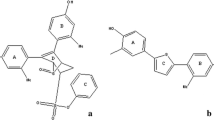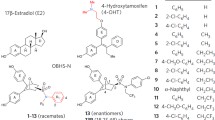Abstract
Estrogen receptors are known drug targets that have been linked to several kinds of cancer. The structure of the estrogen receptor ligand binding domain is available and reveals a homodimeric layout. In order to improve the binding affinity of known estrogen receptor inhibitors, bivalent compounds have been developed that consist of two individual ligands linked by flexible tethers serving as spacers. So far, binding affinities of the bivalent compounds do not surpass their monovalent counterparts. In this article, we focus our attention on the molecular spacers that are used to connect the individual ligands to form bivalent compounds, and describe their thermodynamic contribution during the ligand binding process. We use computational methods to predict structural and entropic parameters of different spacer structures. We find that flexible spacers introduce a number of effects that may interfere with ligand binding and possibly can be connected to the low binding affinities that have been reported in binding assays. Based on these findings, we try to provide guidelines for the design of novel molecular spacers.














Similar content being viewed by others
References
Avendano C, Menendez JC (2008) Medicinal chemistry of anticancer drugs. Elsevier B.V., Amsterdam
Berendsen HJC, Postma JPM, DiNola A, Haak JR (1984) Molecular dynamics with coupling to an external bath. J Chem Phys 81:3684–3690
Bergmann KE, Woogef CH, Carlson KE, Katzenellenbogen BS, Katzenellenbogen JA (1994) Bivalent ligands as probes of estrogen receptor action. J Steroid Biochem Mol Biol 49:139–152
Berube G, Rabouin D, Perron V, N’Zemba B, Gaudreault RC, Parent S, Asselin E (2006) Synthesis of unique 17β-estradiol homo-dimers, estrogen receptors binding affinity evaluation and cytocidal activity on breast, intestinal and skin cancer cell lines. Steroids 71:911–921
Brzozowski AM, Pike ACW, Dauter Z, Hubbard RE, Bonn T, Engstroem O, Oehman L, Greene GL, Gustafsson J, Carlquis M (1997) Molecular basis of agonism and antagonism in the oestrogen receptor. Nature 389:753–758
Bussi G, Donadio D, Parrinello M (2007) Canonical sampling through velocity rescaling. J Chem Phys 126:14–101
Case D, III, TEC, Darden T, Gohlke H, Luo R, Jr., KMM, Onufriev A, Simmerling C, Wang B, Woods R (2005) The Amber biomolecular simulation programs. J Comput Chem 26:1668–1688
Dai SY, Chalmers MJ, Bruning J, Bramlett KS, Osborne HE, Montrose-Rafizadeh C, Barr RJ, Wang Y, Wang M, Burris TP, Dodge JA, Griffin PR (2008) Prediction of the tissue-specificity of selective estrogen receptor modulators by using a single biochemical method. Proc Natl Acad Sci 105(20):7171–7176
Essmann U, Perera L, Berkowitz ML, Darden T, Lee H, Pedersen LG (1995) A smooth particle mesh Ewald method. J Chem Phys 103:8577–8592
Groleau S, Nault J, Lepage M, Couturea M, Dallaire N, Berube G, C-Gaudreault R (1999) Synthesis and preliminary in vitro cytotoxic activity of new triphenylethylene dimers. Bioorg Chem 27(5):383–394
Lee HJ, Lee HB, Andrade JD (1995) Blood compatibility of polyethylene oxide surfaces. Prog Polym Sci 20:1043–1079
Hess B, Bekker H, Berendsen HJC, Fraaije JGEM (1997) LINCS: a linear constraint solver for molecular simulations. J Comput Chem 18:1463–1472
Hess B, Kutzner C, van der Spoel D, Lindahl E (2008) GROMACS 4: algorithms for highly efficient, load-balanced, and scalable molecular simulation. J Chem Theory Comput 4(3):435–447
Horn HW, Swope WC, Pitera JW, Madura JD, Dick TJ, Hura GL, Head-Gordon T (2004) Development of an improved four-site water model for biomolecular simulations: TIP4P-Ew. J Chem Phys 120:9665–9678
Hornak V, Abel R, Okur A, Strockbine B, Roitberg A, Simmerling C (2006) Comparison of multiple Amber force fields and development of improved protein backbone parameters. Proteins 65:712–725
Jakalian A, Bush BL, Jack DB, Bayly CI (2000) Fast, efficient generation of high-quality atomic charges. AM1-BCC model: I. Method. J Comput Chem 21:132–146
Jakalian A, Jack DB, Bayly CI (2002) Fast, efficient generation of high-quality atomic charges AM1-BCC model: II Parameterization and validation. J Comput Chem 23:1623–1641
Jordan VC (2003) Antiestrogens and selective estrogen receptor modulators as multifunctional medicines. 1. Receptor interactions. J Med Chem 46:883–903
Jordan VC (2003) Antiestrogens and selective estrogen receptor modulators as multifunctional medicines. 2. Clinical considerations and new agents. J Med Chem 46:1081–1111
Klimm M, Bujotzek A, Weber M (2010) Direct reweighting strategies in conformation dynamics. MATCH Commun Math Comput Chem 65(2) (in press)
Kreuzer HJ, Wang RLC, Grunze M (1999) Effect of stretching on the molecular conformation of oligo (ethylene oxide): a theoretical study. New J Phys 1:21.1–21.16
LaFrate AL, Carlson KE, Katzenellenbogen JA (2009) Steroidal bivalent ligands for the estrogen receptor: design, synthesis, characterization and binding affinities. Bioorg Med Chem 17:3528–3535
Mammen M, Choi S, Whitesides GM (1998) Polyvalent interactions in biological systems: Implications for design and use of multivalent ligands and inhibitors. Angew Chem Int Ed 37:2754–2794
Ottow E, Weinmann H (2008) Nuclear receptors as drug targets. WILEY-VCH Verlag GmbH & Co. KGaA, Weinheim
Rao J, Lahiri J, Weis RM, Whitesides GM (2000) Design, synthesis, and characterization of a high-affinity trivalent system derived from vancomycin and L-Lys-D-Ala-D-Ala. J Am Chem Soc 122:2698–2710
Salomonsson M, Häggblad J, O’Malley BW, Sitbon GM (1994) The human estrogen receptor hormone binding domain dimerizes independently of ligand activation. J Steroid Biochem Mol Biol 48:447–452
Schmidt-Ehrenberg J, Baum D, Hege HC (2002) Visualizing dynamic molecular conformations. In: Proceedings of IEEE visualization 2002. IEEE Computer Society Press, pp 235–242
Sorin EJ, Pande VS (2005) Exploring the helix-coil transition via all-atom equilibrium ensemble simulations. Biophys J 88(4):2472–2493
Stalling D, Westerhoff M, Hege HC (2005) Amira: a highly interactive system for visual data analysis. In: Hansen CD, Johnson CR (eds) The visualization handbook, chap. 38. Elsevier, UK, pp 749–767
Wang J, Wang W, Kollman PA, Case DA (2006) Automatic atom type and bond type perception in molecular mechanical calculations. J Mol Graphics Model 25:247–260
Wang J, Wolf RM, Caldwell J, Kollman PA, Case DA (2004) Development and testing of a general Amber force field. J Comput Chem 25:1157–1174
Weber M, Andrae K (2010) A simple method for the estimation of entropy differences. MATCH Commun Math Comput Chem 63(2):319–332
Wendlandt AE, Yelton SM, Lou D, Watt DS, Noonan DJ (2010) Synthesis and functional analysis of novel bivalent estrogens. Steroids 75:825–833
Acknowledgments
Support by the Deutsche Forschungsgemeinschaft (SFB 765) is gratefully acknowledged.
Author information
Authors and Affiliations
Corresponding author
Rights and permissions
About this article
Cite this article
Bujotzek, A., Shan, M., Haag, R. et al. Towards a rational spacer design for bivalent inhibition of estrogen receptor. J Comput Aided Mol Des 25, 253–262 (2011). https://doi.org/10.1007/s10822-011-9417-1
Received:
Accepted:
Published:
Issue Date:
DOI: https://doi.org/10.1007/s10822-011-9417-1




